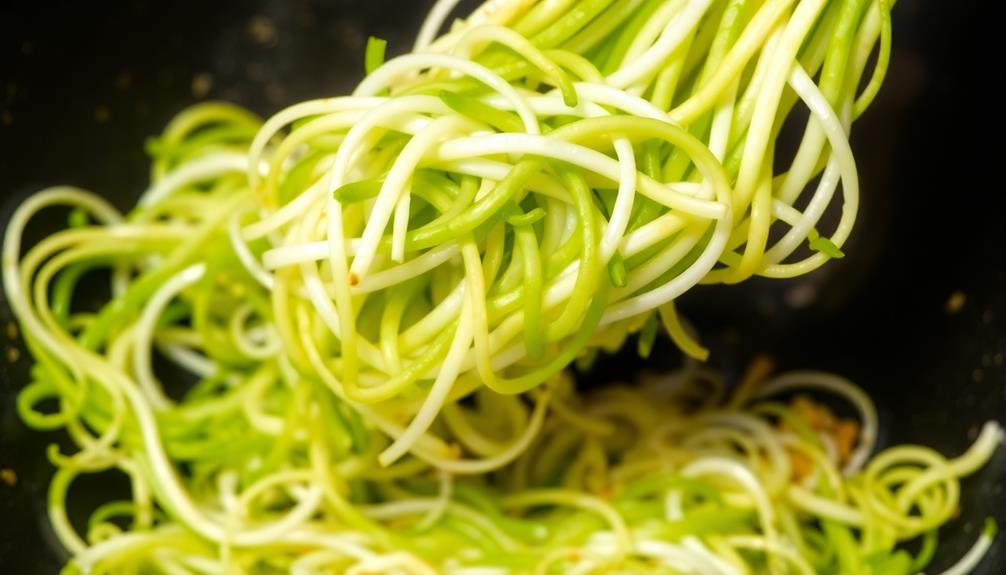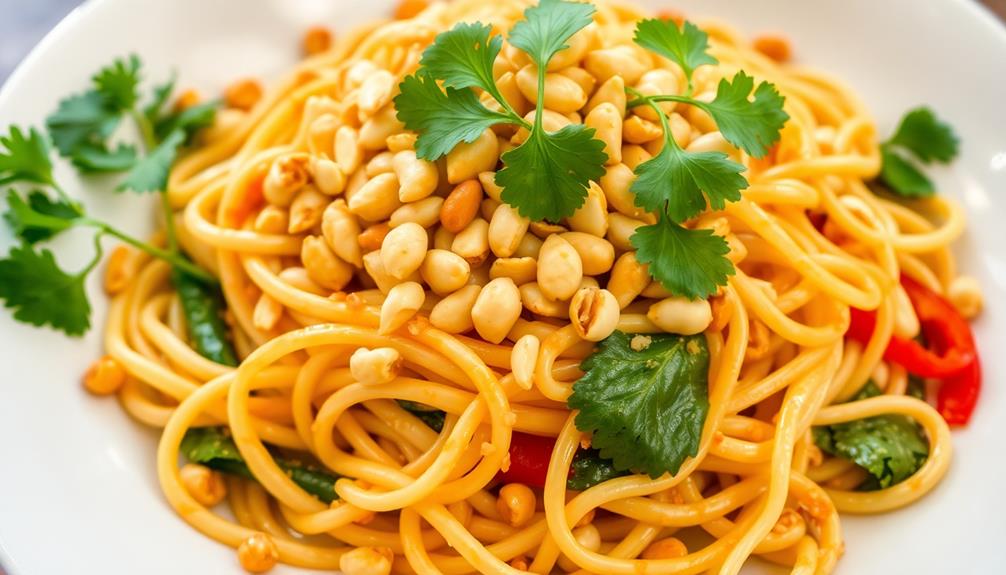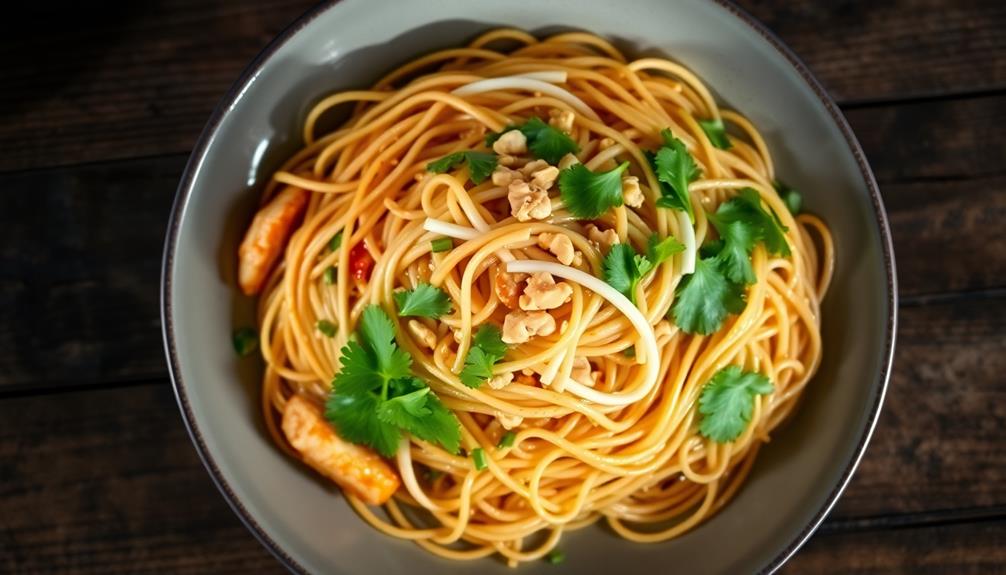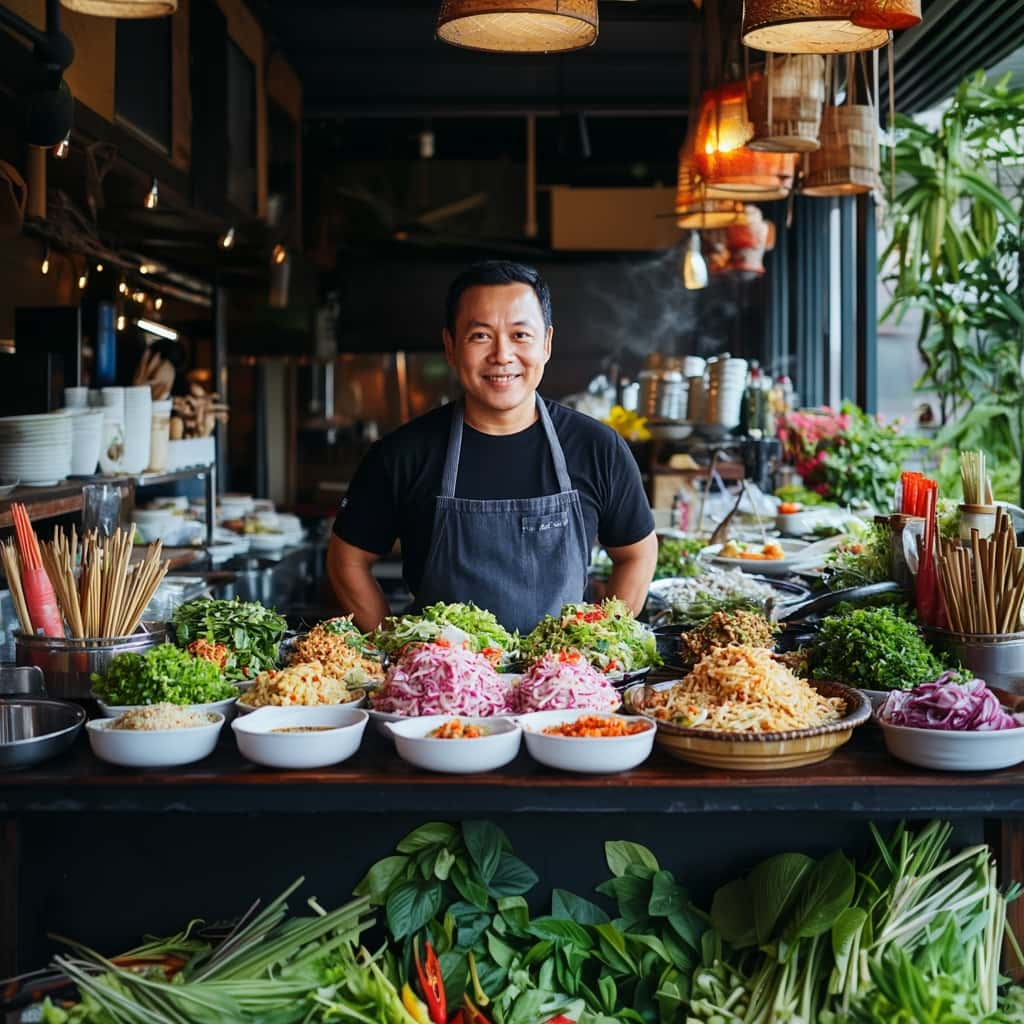Pad Thai's journey from Bangkok's bustling street carts to global fame is a captivating tale. This iconic Thai dish emerged in the 1930s as part of a national campaign to promote Thai culture. Over time, it evolved through regional variations and unique vendor recipes, capturing the vibrant flavors of Thai cuisine. Today, Pad Thai is celebrated worldwide for its perfect balance of sweet, sour, and savory notes. It's a culinary icon that invites exploration of diverse flavor combinations and provides a delightful connection to Thailand's rich food heritage. Ready to discover more about the art of Pad Thai?
Key Takeaways
- The history of pad Thai, originating in 1930s Bangkok as part of a national campaign to promote Thai culture and identity.
- The cultural significance of pad Thai as a culinary icon that embodies the vibrant flavors of Thai cuisine and captivates global audiences.
- The key ingredients, including rice noodles, tamarind paste, fish sauce, and a balance of salty, sweet, and tangy flavors.
- The step-by-step cooking process, from soaking the noodles to stir-frying and garnishing with crushed peanuts and cilantro.
- The enjoyment and experience of pad Thai, offering a delightful sensory experience and a connection to Thai culinary heritage.
History
Pad Thai, Thailand's iconic stir-fried noodle dish, has a rich and captivating history that spans decades. This beloved delicacy was born on the streets of Bangkok, where vendors perfected the balance of sweet, sour, and savory flavors.
It all started in the 1930s when the Thai government encouraged the creation of a national dish to promote Thai culture and identity. Pad Thai quickly became a beloved street food, with each vendor developing their own unique recipe.
Over the years, Pad Thai has evolved, with different regions and chefs putting their own spin on the classic. Some add crushed peanuts, while others experiment with new ingredients like shrimp or chicken.
But no matter the variation, the core elements – rice noodles, fish sauce, tamarind, and a burst of fresh herbs – remain the same.
Today, Pad Thai has become a global sensation, with restaurants around the world serving up their own take on this iconic Thai dish. Its popularity is a testament to the skill and creativity of the Thai people who perfected this delightful culinary masterpiece.
Recipe
Pad Thai is a beloved Thai street food dish that has become popular worldwide. It features a delightful blend of salty, sweet, and tangy flavors, making it a true delight for the senses. The key to a delicious Pad Thai lies in the careful balance of the ingredients and the technique used in its preparation.
The traditional Pad Thai recipe calls for rice noodles, which are stir-fried with a savory sauce, eggs, bean sprouts, and a protein of your choice, often shrimp or chicken. The resulting dish is a harmonious symphony of textures and flavors, making it a satisfying and comforting meal.
Ingredients:
- 8 oz rice noodles
- 2 tbsp tamarind paste
- 2 tbsp fish sauce
- 2 tbsp brown sugar
- 1 tbsp soy sauce
- 2 cloves garlic, minced
- 2 eggs, beaten
- 1 cup cooked shrimp or chicken, chopped
- 1 cup bean sprouts
- 2 green onions, sliced
- 2 tbsp crushed peanuts
- 1 lime, cut into wedges
Cooking Instructions:
In a wok or large skillet, heat a tablespoon of oil over medium-high heat. Add the garlic and stir-fry for 30 seconds until fragrant.
Pour in the beaten eggs and scramble them, breaking them up into small pieces. Add the rice noodles, tamarind paste, fish sauce, brown sugar, and soy sauce. Toss everything together until the noodles are evenly coated and heated through.
Finally, stir in the cooked shrimp or chicken, bean sprouts, and green onions. Cook for an additional 1-2 minutes, ensuring the ingredients are well combined and heated.
Tips:
For best results, use freshly prepared rice noodles, which have a better texture and absorb the flavors more effectively. If using dried noodles, be sure to soak them in warm water until they're pliable before stir-frying.
Additionally, adjust the seasoning to your personal taste, adding more fish sauce for saltiness or brown sugar for sweetness. Serve the Pad Thai hot, garnished with crushed peanuts and a squeeze of fresh lime juice for a bright, tangy finish.
Cooking Steps
Alright, let's dive right into the cooking steps for this tasty Thai Pad Thai!
First, you'll want to soak those rice noodles in some hot water until they're nice and soft.
Then, it's time to stir-fry those noodles with the delicious sauce mixture.
Don't forget to add the scrambled eggs and the crunchy bean sprouts for the perfect texture.
Step 1. Soak Rice Noodles in Hot Water

To begin, soak the rice noodles in hot water until they're pliable and tender, which typically takes around 5-10 minutes. This is a crucial first step in making delicious Pad Thai.
Make sure the water is hot, but not boiling, as that could make the noodles too soft. Gently stir the noodles every now and then to ensure they soak evenly.
Once they've softened, drain the noodles and set them aside. They're now ready to be added to the stir-fry. This pre-soaking step helps the noodles cook quickly and absorb all the wonderful flavors later on.
Be patient and take your time – you don't want to rush this part. With the noodles ready, you can now move on to the next step: heating up your wok and adding the other fresh ingredients.
Get ready for the sights, sounds, and mouthwatering aromas of authentic Thai Pad Thai!
Step 2. Stir-Fry Noodles With Sauce Mixture

Next, heat a large wok or skillet over medium-high heat. Once it's nice and hot, add a little oil to the pan.
Toss in the soaked rice noodles and stir-fry them for a minute or two, just until they start to soften up. Now it's time to add the sauce mixture you prepared earlier. Pour it right into the pan and keep everything moving with your spatula. The noodles will start to soak up all that delicious flavor.
Sprinkle in a pinch of sugar and a dash of fish sauce to balance out the sweetness and saltiness. Keep stir-frying for another couple of minutes until the noodles are cooked through but still have a nice bite to them. You want them to be tender but not mushy.
As the noodles cook, toss in some bean sprouts and chopped green onions. Give everything a final stir to incorporate all the flavors.
Step 3. Add Scrambled Eggs

Once the noodles are nearly cooked through, push them to the side of the wok to create a small well. Crack a couple of eggs right into this little space and let them sit for a moment.
As the eggs start to set, use your spatula to gently scramble them, mixing them into the noodles. The warm eggs will coat the noodles, adding a creamy texture and rich flavor. Be sure to keep everything moving in the wok, so the eggs don't overcook and become rubbery.
The goal is soft, tender scrambled eggs that blend seamlessly with the noodles. Once the eggs are just cooked through, give everything a good toss to distribute the ingredients evenly.
This simple addition of eggs takes your Pad Thai to the next level, adding an extra layer of indulgence. The creamy, eggy noodles are the perfect base for the sweet and tangy sauce to cling to.
Step 4. Add Bean Sprouts

After the eggs have been incorporated, it's time to add the bean sprouts. These crunchy, fresh veggies will bring a delightful texture and crunch to your Pad Thai. Grab a handful of bean sprouts and toss them into the pan.
Stir everything together, making sure the sprouts are evenly distributed throughout the dish. As the bean sprouts cook, they'll release their natural juices, which will help to create a more saucy and flavorful Pad Thai.
The crisp texture of the sprouts will also provide a nice contrast to the soft noodles and tender shrimp or chicken. Remember to keep the heat at a medium-high level, so the bean sprouts don't overcook and become soggy.
You want them to maintain their crunch and freshness. After a minute or two of stir-frying, your Pad Thai should be ready for the final touches. Get excited, as the addition of the bean sprouts is sure to take your dish to new heights of flavor and texture!
Step 5. Garnish With Crushed Peanuts and Cilantro

To complete the Pad Thai, garnish the dish with crushed peanuts and fresh cilantro. This final touch adds a delightful crunch and a vibrant burst of flavor.
First, take a handful of roasted peanuts and place them in a plastic bag. Use a rolling pin or the back of a spoon to gently crush the peanuts into smaller pieces. You don't want to pulverize them completely – leave some nice, chunky bits for texture.
Next, pluck a few sprigs of fresh cilantro and give them a rough chop. The bright, herbal flavor of the cilantro pairs beautifully with the nutty peanuts and the savory Pad Thai.
Sprinkle the crushed peanuts and chopped cilantro over the top of your Pad Thai, distributing them evenly. The combination of crunchy peanuts, zesty cilantro, and the flavorful noodle dish will delight your senses and leave you wanting more.
Enjoy your freshly garnished Pad Thai!
Final Thoughts
Pad Thai is a beloved Thai dish that has captured the hearts and taste buds of people around the world. From the bustling street carts of Bangkok to high-end restaurants across the globe, this delightful noodle dish has become a culinary icon, showcasing the vibrant flavors and rich traditions of Thai cuisine.
As you've discovered, the secrets to crafting the perfect Pad Thai lie in the careful balance of sweet, sour, and savory elements, as well as the skillful technique of the chef. Whether you prefer it with shrimp, chicken, or tofu, the combination of rice noodles, eggs, bean sprouts, and a tantalizing sauce is simply irresistible.
As you savor the final bites, take a moment to appreciate the centuries-old heritage and the passion that goes into every plate of Pad Thai. This dish isn't just a meal, but a celebration of Thailand's rich culinary legacy and its ability to captivate and delight people from all walks of life.
Frequently Asked Questions
What Is the Difference Between Thai and American Pad Thai?
Thai pad thai is more authentic, with a balance of sweet, sour, and savory flavors, while American pad thai is often sweeter, saltier, and sometimes contains ingredients not traditionally used in the Thai version, like chicken or beef.
How Can I Find Authentic Pad Thai Ingredients in My Local Market?
To find authentic pad thai ingredients, check your local Asian or international markets. Look for tamarind paste, fish sauce, palm sugar, rice noodles, and dried shrimp. You may also find fresh bean sprouts and crushed peanuts to complete the dish.
Can Pad Thai Be Made Vegetarian or Vegan-Friendly?
You can absolutely make pad thai vegetarian or vegan-friendly! Simply swap out the traditional proteins like shrimp or chicken for tofu, and use vegetable-based fish sauce or soy sauce to create a delicious meat-free version of this iconic Thai dish.
What Are the Best Garnishes to Top Pad Thai?
The best garnishes to top your pad thai are crushed peanuts, fresh bean sprouts, sliced green onions, crushed red pepper flakes, and a squeeze of fresh lime juice. These toppings add crunch, heat, and brightness to the classic Thai noodle dish.
How Long Can Leftover Pad Thai Be Stored in the Fridge?
Leftover pad thai can be stored in the fridge for up to 3-4 days. Make sure to store it in an airtight container and reheat it thoroughly before enjoying. Avoid letting it sit out at room temperature for too long.









